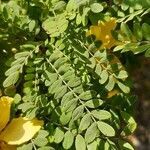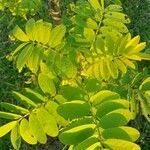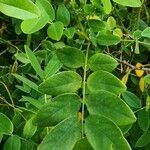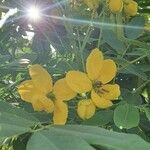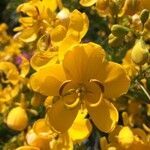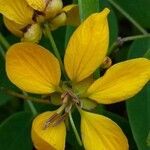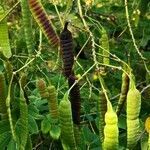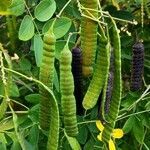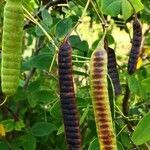Shrub or small tree up to 7 m tall; young branches puberulous. Stipules linear falcate, 5-10 mm long, subpersistent. Leaves with 6-9 pairs of leaflets; petioles 1.5-3 cm; rachis up to 15 cm with a clavate, 1-2 mm long gland between the 2 or 3 lower pairs of leaflets. Leaflets with short petiolule, ovate to ovate-oblong, 2.5-4 by 1-1.7 cm; upper surface glabrous, lower sparsely pubescent; apex rounded, more or less slightly emarginate, base rounded, rarely cuneate. Racemes from the upper leaf axils, 3-6 cm long, 10-15-flowered; peduncle 2.5-5 cm; bracts ovate acute, 4-5 mm long, finally reflexed; pedicels 1-2 cm. Sepals: 2 outer more or less orbicular, c. 3 mm long; 3 inner obovate up to 7 mm long. Petals yellow, subequal, ovate-obovate, 1.5-2 cm long with a 1-1.5 mm long, narrow claw. Stamens 10 fertile, with short, thick filaments, 1-4 mm long; anthers subequal, 5-7 mm long, opening by apical slits. Ovary puberulous; style glabrous; stigma indistinct. Pods flat, glabrous with papery valves, 7-10 by 1-1.5 cm. Seeds 15-25, glossy flattened, 8 by 4 mm.
Shrub or small tree to 11 m high, variably golden-pubescent or glabrescent. Leaves 5–15 (–20) cm long including a channelled petiole 20–40 (–65) mm long; stipules acicular, usually caducous; leaflets in 4–10 pairs spaced c. 15 mm apart, elliptic to slightly obovate, (20–) 25–75 (–100) mm long, 10–20 mm wide, increasing distally, obtuse, rounded or emarginate; glands 2–5, between the lowest leaflet pairs, stipitate. Inflorescence subumbellate, of 4–10 flowers, in upper axils; peduncle 20–60 mm long; pedicels 15–30 mm long; bracts ± persistent. Petals 10–24 (–30) mm long. Fertile stamens 10; filaments subequal, 1–2 mm long, or 1 longer (to 5 mm); anthers subequal, 5–6 mm long. Pod flat, 8–15 cm long, 10–15 mm wide, straight, entire. Seeds glossy, with a linear areole.
A shrub or small tree. It grows 2-7 m tall. It spreads to 4 m across. The branches can have hairs or be smooth. The leaflets are in 4-7 pairs. They are 3-10 cm long by 1.5-5 cm wide. The leaf axis has glands between the lower 2-4 pairs of leaflets. The flower cluster is 5-13 cm long with 10-20 flowers. The petals are yellow and 2-3 cm long. The fruit are flat and thin. They are 15-20 cm long and 1.2-1.8 cm wide. They can be straight or curved. The pods are divided by partitions. The seeds are blackish and 9-10 mm long by 3.5-4 mm wide. They are shiny. The seed scar is one sided and nearly at the end of the seed.
